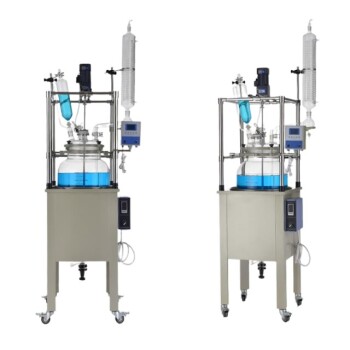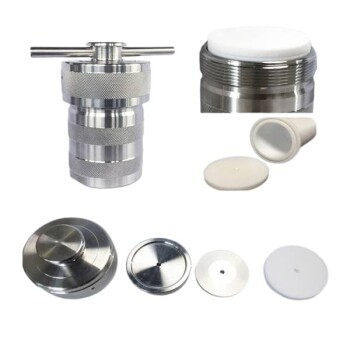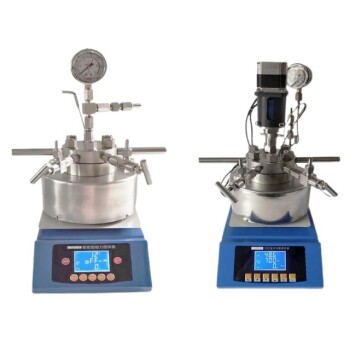A glass reactor is a versatile piece of equipment widely used in chemical, pharmaceutical, and research laboratories for various processes such as mixing, chemical reactions, and temperature-controlled experiments. Its primary components include the reactor body, typically made of borosilicate glass for durability and thermal resistance, and a lid with multiple ports for connecting accessories like stirrers, condensers, and thermoprobes. The reactor often features a jacketed design for temperature regulation, a centrally mounted agitator for mixing, and functional ports for material addition and recovery. Additional components such as baffles, a drain port, and a stainless steel frame provide structural support and enhance functionality. Below is a detailed breakdown of the key components and their roles.
Key Points Explained:

-
Reactor Body
- The main component of a glass reactor is the reactor body, typically a cylindrical vessel made of borosilicate glass.
- Borosilicate glass is chosen for its durability, thermal shock resistance, and chemical inertness, making it suitable for handling corrosive substances and extreme temperatures.
- The reactor body comes in various sizes, ranging from 50 ml to 200 liters, depending on the application.
-
Lid with Ports
- The reactor is equipped with a lid that has multiple ports or valves for connecting accessories.
- These ports allow the integration of components such as stirrers, condensers, thermoprobes, and feed tubes, enabling precise control over the reaction process.
- The lid ensures a sealed environment, which is essential for controlling reflux, evaporation, and pressure during reactions.
-
Jacket for Temperature Regulation
- Many glass reactors feature a jacketed design, where the reactor body is surrounded by a double-walled structure.
- The jacket allows for the circulation of heating or cooling fluids (e.g., water, oil, or steam) to regulate the temperature of the reaction mixture.
- This feature is critical for maintaining consistent reaction conditions, especially in processes sensitive to temperature fluctuations.
-
Agitator (Stirrer)
- A centrally mounted agitator is a key component for mixing chemicals uniformly.
- The agitator is typically driven by a transmission device and can be adjusted for speed and direction to achieve optimal mixing efficiency.
- In some designs, baffles are added to the reactor to create turbulence, ensuring thorough mixing and preventing the formation of dead zones.
-
Drain Port
- Located at the bottom of the reactor, the drain port facilitates the emptying or recirculation of liquid contents.
- This feature is particularly useful for processes requiring continuous operation or the recovery of reaction products.
-
Stainless Steel Frame
- The glass reactor is supported by a stainless steel frame, typically made of SUS304 stainless steel.
- The frame provides structural stability and ensures the reactor can withstand mechanical stress during operation.
- It also houses the transmission device and other mechanical components.
-
Sealing Components
- PTFE (Polytetrafluoroethylene) is commonly used for sealing components due to its chemical resistance and ability to maintain a tight seal under various conditions.
- Proper sealing is essential for preventing leaks, especially in high-pressure or vacuum applications.
-
Additional Features
- High-pressure glass reactors are designed with corrosion-resistant materials to handle reactions under elevated pressure.
- Functional ports for material addition and recovery enhance the reactor's versatility, allowing for continuous operation and easy sampling.
- The reactor may also include safety features such as pressure relief valves and temperature sensors to ensure safe operation.
In summary, a glass reactor is a sophisticated piece of equipment composed of several critical components that work together to enable precise control over chemical reactions. Its design emphasizes durability, functionality, and safety, making it an indispensable tool in modern laboratories and industrial settings.
Summary Table:
| Component | Function |
|---|---|
| Reactor Body | Made of borosilicate glass for durability, thermal resistance, and chemical inertness. |
| Lid with Ports | Enables connection of accessories like stirrers, condensers, and thermoprobes. |
| Jacket for Temperature | Regulates temperature using heating/cooling fluids for consistent reactions. |
| Agitator (Stirrer) | Ensures uniform mixing of chemicals with adjustable speed and direction. |
| Drain Port | Facilitates emptying or recirculation of liquid contents. |
| Stainless Steel Frame | Provides structural stability and houses mechanical components. |
| Sealing Components | Made of PTFE for chemical resistance and leak prevention. |
| Additional Features | Includes safety features like pressure relief valves and temperature sensors. |
Upgrade your lab with a high-performance glass reactor—contact us today for expert advice!














